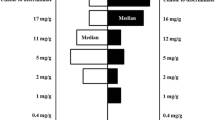Abstract
To test whether cigarettes with low tar, low carbon monoxide, and medium nicotine yield produce less dangerous effects than cigarettes low in tar and CO but high in nicotine, 12 subjects were recruited to smoke nicotine-enriched cigarettes. The subjects smoked three types of cigarettes in the three experimental conditions: (1) their own brand; (2) cigarettes with 4.8 mg tar, 4.0mg CO, and 0.5 mg nicotine; (3) cigarettes with 5.8 mg tar, 4.1 mg CO, and 1.1 mg nicotine. Subjects monitored their daily consumption for 12 weeks; 4 weeks for each condition. During laboratory visits, the subjects smoked a cigarette while their heart rate and carbon monoxide in expired air were measured pre- and post-smoking. A blood sample was drawn and analyzed for nicotine and cotinine in each experimental condition. No significant differences in daily cigarette consumption were found, although a trend (P<0.07) in the direction of fewer nicotine-enriched cigarettes per day was found. Levels of CO varied significantly among the three conditions: The subjects' own brands yielded the highest level, while the nicotine-enriched cigarette yielded the lowest level. No differences were found for nicotine or cotinine levels. A second purpose of the experiment was to record the degree of nicotine titration displayed by individual smokers, tar and CO levels remained constant in the experimental cigarettes. No general titration effect was observed, although for daily consumption it approached significance. When the subjects' nicotine dependence, measured with a tolerance questionnaire, was taken into acount, a correlation with daily consumption was found (r=77, P<0.005). A cigarette with low tar and CO, but medium to high nicotine yield, would seem to produce less hazardous effects and is worthy of further investigation. The controversial question of whether smokers titrate for nicotine is a function of the individual's nicotine dependence.
Similar content being viewed by others
References
Dunn PJ, Freiesleben ER (1978) The effects of nicotine-enhanced cigarettes on human smoking parameters and alveolar carbon monoxide levels. In: Thornton RE (ed) Smoking behavior. Churchill Livingstone, New York
Fagerström K-O (1978) Measuring degree of physical dependence to tobacco smoking with reference to individualization of treatment. Addict Behav 3:235–241
Fagerström K-O (1981) Tolerance, withdrawal and dependence on tobacco and smoking termination. Int Rev Appl Psychol. In press
Fagerström K-O, Bates S (1981) Compensation and effective smoking by high and low nicotine-dependent smokers. Addict Behav 6:331–336
Goldfarb T, Gritz ER, Jarvik ME, Stolerman IR (1976) Reactions to cigarettes as a function of nicotine and ‘tar’. Clin Pharmacol Ther 19:767–772
Gori GB, Lynch CJ (1978) Toward less-hazardous cigarettes. JAMA 240:1255–1259
Gritz ER (1980) Smoking behavior and tobacco abuse. In: Mello NK (ed) Advances in substance abuse, JAI, New York, pp 91–158
Hill P, Marquardt H (1980) Plasma and urine changes after smoking different brands of cigarettes. Clin Pharmacol Ther 27:652–658
Jaffe JH, Kanzler M, Friedman L, Stunkard AJ, Verebey K (1981) Carbon monoxide and thiocyanate levels in low tar-nicotine cigarettes. Addict Behav 6:337–344
Louis AM (1980) The $150 million cigarette. Fortune 17:121–123
Russell MAH, Wilson C, Patel UA, Cole PV, Feyerabend C (1973) Comparison of the effect on tobacco consumption and carbon monoxide absorption of changing to high and low nicotine cigarettes. Br Med J 4:512–516
Russell MAH (1976) Low-tar medium-nicotine cigarettes: A new approach to safer smoking. Br Med J 1:1430–1433
Russell MAH (1978) Self-regulation of nicotine intake by smokers. In: Bättig K (ed) Behavioral effects of nicotine, Karger, Zurich, pp 108–122
Russell MAH (1980) The case for medium-nicotine, low-tar, low-carbon monoxide cigarettes. In: A safe cigarette? Banbury Report 3, Cold Spring Harbor Laboratory, New York, pp 297–308
Author information
Authors and Affiliations
Rights and permissions
About this article
Cite this article
Fagerström, KO. Effects of a nicotine-enriched cigarette on nicotine titration, daily cigarette consumption, and levels of carbon monoxide, cotinine, and nicotine. Psychopharmacology 77, 164–167 (1982). https://doi.org/10.1007/BF00431941
Received:
Accepted:
Issue Date:
DOI: https://doi.org/10.1007/BF00431941




